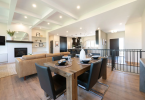
Designed by Luc Crawford
Your child’s bedroom is their ultimate comfort zone, and it should be designed to please all the senses. It is their sanctuary – a place to play, read, sleep and study.
Text by Luc Crawford, As Seen In Canadian Home Trends, Winter 2014
Room Elements
Define how your child’s bedroom will be used. Are they studying, reading or playing in the room? Make a priority list of what you would like to be integrated within the space. Use different textured fabrics in different tones of the same or different colours to build a playful look for the bed.
The bed is the centerpiece in the room, so consider not only its comfort and look, but also its proportion within the space. Low, wide headboards create a streamlined effect, and integrated bedside units provide plenty of drawers and bedside surface space.
Storage is important in any kids’ bedroom and must be well designed to provide ample room to neatly organize all their clothes, shoes and accessories.
Lighting must be controllable via a light switch located beside the bed or doorway. Also consider adding a dimmer in order to set the lighting level for different uses such as reading, playing or studying.
Bedside lamps are an essential element and can make a statement in a bedroom. In this particular setting, a lamp would be a fantastic reading light and a wonderful way to add style to the overall design plan.
Shutters or side panels are a chic and practical window treatment. Use a fabric with a pattern and a fun rod to add a touch of whimsy to your space.
Furniture should be functional and comfortable in a kids’ bedroom. A bench at the end of the bed is good for getting dressed and can be used as a reading area. In my opinion, a vanity with a vintage chair is every girl’s best friend.
Always think about layering. Subtle tones, vibrant colours and textures in fabrics make a world of a difference in a space. Consider using glazed linen for a kids’ room as the fabric will last forever even through their teenage years.
Kids’ zone checklist
- Communication is KEY. Talk to your kids to find out what they really want in their room. You will learn a great deal and create a functional design plan.
- Create inspiration boards by cutting kids’ spaces out of your favourite magazines. Turn them into mood boards with your children, to make their vision of the space come to life.
- Work with their ideas, and play with texture and colour as much as you can when choosing materials and furnishings.
- Design the room to evolve with your child as he or she grows up, so that your investment has a long lifespan.
Latest posts by Canadian Home Trends (see all)
- Layer Up – Wrap Your Bathroom In Light - January 4, 2026
- The Power of Rest: Elevate Your Wellness with Better Sleep - January 4, 2026
- VERSATILE KITCHEN DESIGN - January 4, 2026






